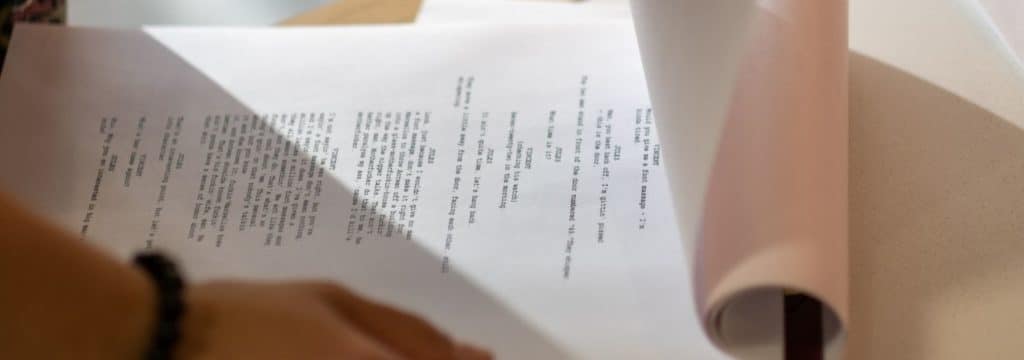
Ask most people what a scriptwriter does, and they’ll probably have a pretty good idea. Ask them what a script reader, does, however, and they’ll probably go blank. Script readers are film and TV’s behind-the-scenes gatekeepers.
They’re the first to read a screenplay, and can make or break a project’s future.
You’ll find script readers working for production companies, financiers and writers. They help producers pick projects to fit there slates. They help writers improve their work. They help shortlist finalists in screenwriting competitions. But no matter who they’re working for, the core of the job’s the same: give an informed opinion on a screenplay.
It’s the kind of position that can lead just about anywhere, because the fact is, when you come down to it, scripts are the language of cinema – and the best way to learn a language is to get speaking it.
But how do you become a script reader? Let’s break it down.
Step 1 – Developing Your Understanding of Storytelling
When first learning about screenwriting, you’ll see the same books mentioned again and again. Robert McKee’s ‘Story’, John Yorke’s ‘Into the Woods’ and Blake Snyder’s ‘Save the Cat’ are just a few. Each author has their own theory on how screenwriting works. However, the foundation of screenwriting theory is largely the same from author to author.
One concept you’ll frequently run into is three-act structure. This model divides a script into three parts: the setup, the confrontation and the resolution.

- Act 1 (setup) introduces our main character, or protagonist. The protagonist has a goal, which will drive the action of the script. During Act 1, an ‘inciting incident’ occurs. This sets the protagonist’s journey to achieve their goal in motion.
- Act 2 (confrontation) represents the bulk of the action in the screenplay. Here, we watch the protagonist pursue their goal in the face of escalating obstacles. We don’t want a protagonist who simply reacts as things happen to them. We want them to be proactively taking steps to achieve their main aim. Take Phil Connors in Groundhog Day. He doesn’t know how to stop the day repeating, but that certainly doesn’t stop him trying.
Protagonists must also be clearly flawed, and normally their goal involves having to confront that flaw. A story lives or dies by its characters. They can quite literally make or break a screenplay.
- In Act 3 (resolution), the protagonist either achieves their goal or fails. If they fail, it’s normally because of their own fatal flaw. How a script ends is largely determined by genre. Understanding different genres and their expectations is also crucial for evaluating scripts. Every genre comes with its own tropes.
For example, in a thriller screenplay, we want fast-paced action and a sense of urgency. In a romcom, we want loveable characters who find happiness together. Assessing how effectively a writer meets the expectations of their chosen genre is a good starting point for a strong report.
Step 2 – Read, Read, Read!
It might sound obvious, but one of the most crucial steps in becoming a proficient script reader is familiarising yourself with reading scripts. Unlike just about any other form of fictional writing, a screenplay is not a finished product. It’s not even designed to be read in raw form. It’s the spine of a film or show, the blueprint the creative team will follow.
As a script reader, you need an insight into how what starts on the page ends up on screen. Most people don’t grow up reading scripts like we grow up reading books. Because of that, it can take some practice to become used to the screenplay format.
A great starting point is to read screenplays of films/TV shows you’re already very familiar with. There’s a treasure trove of classic scripts online on websites like simplyscripts.com and imsdb.com.
You can also visit Youtube channels like From Script to Screen and The Script Lab to see film/TV clips in real time played alongside the original scripts.
Remember, when working as a reader, you need to be assessing potential. Once you get the hang of what a finished film or show originally looked like as a script, you’ll be able to work the opposite way round and visualise what a raw screenplay may end up looking like on screen.
It’s also good to get in the habit of reading actively. Develop a system for making notes; find a method that works for you. Annotate or highlight scripts if you want to. If you like a good spreadsheet, make a table to break down a script into its key components and acts.
Sometimes, you might come across changes between the script you read and the finished product. Note down some thoughts on why those changes might have been made and how well they do/don’t work.

Step 3 – Learn How to Evaluate Scripts
When you get into the practice of reading scripts, the next stage is to learn how to apply the storytelling knowledge you’ve gained in Step 1 into developing a strong critical eye. The structure of an actual script report varies from company to company. A lot of companies simply ask for a synopsis and an accompanying commentary. Reports that go directly to writers tend to be more detailed and specific, breaking into separate categories like premise, character, dialogue, structure, pace and visual grammar.
When developing your critical eye, it’s a good idea to make notes on scripts you read under these headings. A helpful way to tackle this is to essentially ask yourself questions about the script you’ve read. The answers to these questions will then inform the notes you make.
For example:
Premise – Can you easily identify the dramatic premise of the story? Who’s the lead character? What’s their goal? Where’s the source of conflict? What’s at stake if the protagonist doesn’t achieve their goal?
Character – Do these characters’ motivations make sense? Are they active, or too passive? Are they flawed? Are their flaws relatable? Do they feel three-dimensional?
Dialogue – Do characters have distinct voices? Does dialogue feel realistic? Is there too much exposition? Is too much being said instead of shown?
Structure – How well does the script fit three-act structure? Is there a clear inciting incident? Does one plot point logically follow another? Is the ending satisfactory?
Pace – Is the pacing consistent? Does the script ever drag? Do things ever feel too rushed? Is too much action crammed into a short space?
Visual grammar – Does the film/show’s setting enhance the story? Do the scene directions paint a compelling image for the reader?
You can make notes on these elements on shows/films you watch as well as screenplays you read.
We all instinctively form opinions on the shows/films we consume. What you’re learning to do here is go further with these opinions. If you feel strongly about something you’ve watched, try breaking it down into the elements above. Try and pinpoint exactly what is or isn’t working. This process becomes more and more automatic the more you practise.
Step 4 – Build Your Knowledge of the Industry
Oftentimes, one of the things producers will ask for in a script report is for a comparison to similar projects. What can you compare the script you’re reading to? Are there similar films and shows coming out? How successful have they been? The best way to build up a strong knowledge base on this kind of thing is to read industry-specific publications, like Screen Daily, Broadcast and Deadline.

They’ll also have articles about where the key players in the industry are working. If new, exciting production companies are being set up, you’ll read about it in these publications first.
You can perform your role more effectively when you have an overview of the development process. ‘Adventures in the Screen Trade’, by William Goldman, is somewhat dated but is still a classic on Hollywood screenwriting. An invaluable resource that’s more recent is ‘The Screenplay Business’ by Peter Bloore. This includes contributions from professionals at every stage of the development journey. Understanding the business side of screenplays is crucial. It’s just as important as the editorial side.
Networking is also vital.
A search on Facebook will uncover some useful groups for industry freelancers. LinkedIn can be a godsend. Connect with people in the industry you admire. Send a note inviting them for coffee. Everyone understands how tough the industry can be. Most will be happy to help. The best places to network in person are often film festivals, like LFF and Raindance. There’s even an event called the London Screenwriter’s Festival. It’s chock-full of development execs, literary agents and screenwriters.
If you’re struggling to afford these events, try volunteering! It’s a great way to see behind the curtain and potentially make some really useful contacts.
Step 5 – Start Practicing
Script reading jobs can be hard to come by. Positions are rarely advertised. The organizations that issue formal callouts for readers, such as the BBC and the BFI, tend to be larger. They also tend to ask for more previous experience. Starting out by targeting voluntary gigs is a good way to gain this experience.
Peer-to-peer review sites like Coverfly X and Script Mother are good places to start. Competitions run by organizations like ScreenCraft and The Script Lab UK also rely on volunteer readers. Keep an eye on their Twitter for opportunities.
The aim is to build up a portfolio of coverage. Paid reading opportunities for production companies often come about through cold emailing. They’ll want to see a sample of your work. You can even practice by writing reports on spec scripts sent to sites like Script Revolution, even if you don’t send them to the writer. With practice, you’ll become better at articulating yourself. You’ll also most likely find the same notes coming up again and again.
Asking for feedback on your work is crucial to building your expertise. Offer a writer a chat over Zoom to go through the notes you’ve given. This will give you an idea of how clear your notes are. Don’t be scared to ask professional clients for feedback as well. Every organization has its own requirements when it comes to coverage. Tailoring your reports to the individual client is a skill you’ll need to master. For this reason, feedback’s always invaluable, even as you become more experienced.

Step 6 – Promote Yourself and Build Your Reputation
Marketing yourself is essentially a form of networking that’s a little bit more targeted. Social media’s a good place to start. Look for both script reading/editing groups on Facebook and groups just for screenwriters. Advertise your services, and name-drop some of the bigger organizations you’ve got experience reading for in the past.
Linkedin is another one – search for aspiring screenwriters and connect with them. On Linkedin, there’s also an option whereby you can get past/present employers to endorse your skills with the click of a button. Even better is the recommendation option: if they’re comfortable, clients can write a short paragraph about your aptitude as a reader.
It’s worth considering setting up a website yourself. Think of this as an extended CV with a personal touch. You can talk about experience, and the kind of projects you’re excited about becoming involved with. This is also a handy place to put any lovely comments from satisfied clients. You can start setting your own rates for coverage (ask around on social media to get some idea of an appropriate price given your experience).
If you’ve got time, it can be a smart move to blog about film and TV more generally. This is particularly useful if you don’t have much coverage experience, as it at least gives potential clients a flavour of your taste and writing style.
Again, face-to-face opportunities are always ideal, so keep on top of industry events like the film festivals mentioned previously. Use social media to reach out to people working on material you admire. Always personalize your communication – never send out a standard cold email as it will likely be discarded. Take advantage of any contacts you make. For example, you may be applying for in-house development jobs. If you’re unsuccessful, offer your services as a reader instead – there’s no better way to prove your aptitude.
Step 7 – Keep Learning and Improving
There are lots of opportunities to keep building on your script reading skillset. Perhaps the most renowned script development course in the UK is the NFTS’s Diploma in Script Development, which gives any reader a really strong grounding. John Yorke, author of Into the Woods, runs an online course in Story for Script Development.
Experienced reader Lucy V Hay runs a two-day Breaking into Script Reading workshop. Industrial Scripts run Effective Script Reading courses both online and in-person.
These courses can come with a hefty price tag. However, if you’re employed in-house, you can potentially be sponsored. Bursaries are also available through ScreenSkills to further your career.
Another great thing these courses offer is yet more opportunity to network. Guest speakers/lecturers will share their skillsets and can be useful contacts for the future. It can also be rewarding to build a network of readers at a similar stage to you. Reading can be quite an isolating job, so finding a community can really enrich your professional life.
Remember that the industry is ever-changing. Keep reading the trades, and keep watching new content. Being savvy on the latest shows and films will look good in interviews and meet-ups. Plus, it’s a great excuse to enjoy some quality entertainment!
Conclusion
Script reading is one of the best starter gigs out there in film and TV. This is partly because it can lead almost anywhere. It’s flexible and it’s engaging. It is, however, a tough nut to crack. It’s a sad fact that most people’s trajectory in script development is not a straight line. If it’s what you want to do, the industry will always need readers. But you’ll definitely have to hustle to get there.
So, let’s go back over these steps in short-form. Start by learning as much about screenwriting theory as you can. Start reading any script you can get your hands on. Learn about what a typical script report looks like (the Internet is full of examples). Start attempting them yourself. Learn about the industry itself. Read the trades and attend industry events. Start hustling for work (social media is your friend!). Contact people you look up to in the industry and ask for advice. Build your reputation. Build your skills along with it.
Simple, right? Don’t be fooled.
This is a career path that requires considerable determination. You will almost certainly need a day job to put food on the table. Work can fluctuate, even when you’ve got multiple clients. But stick with it, and you never know where it will take you.

